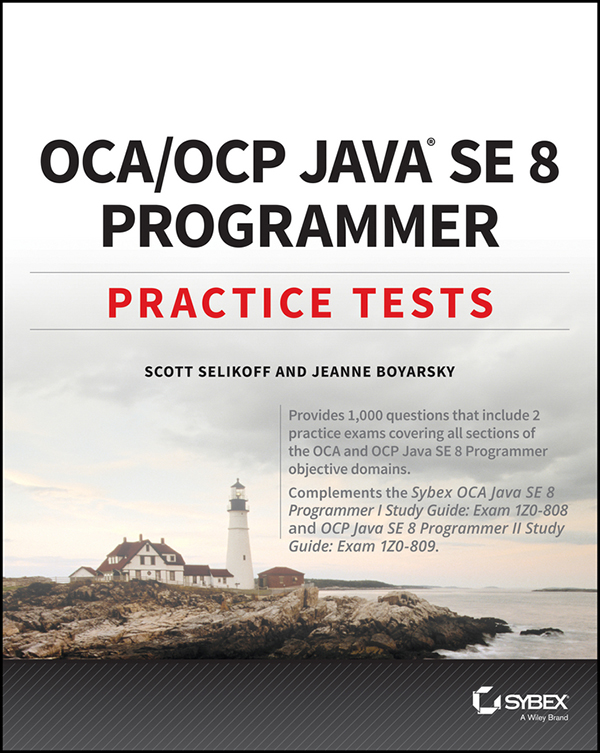OCA / OCP Java SE 8 Programmer Practice Tests by Scott Selikoff

Author:Scott Selikoff
Language: eng
Format: epub
ISBN: 9781119363361
Publisher: Wiley
Published: 2017-03-02T03:00:00+00:00
Chapter 2: Working with Java Data Types
A. Option A does not compile because Java does not allow declaring different types as part of the same declaration. The other three options show various legal combinations of combining multiple variables in the same declarations with optional default values.
D. The table variable is initialized to "metal". However, chair is not initialized. In Java, initialization is per variable and not for all the variables in a single declaration. Therefore, the second line tries to reference an uninitialized local variable and does not compile, which makes Option D correct.
B. Instance variables have a default value based on the type. For any non-primitive, including String, that type is a reference to null. Therefore Option B is correct. If the variable was a local variable, Option C would be correct.
B. An identifier name must begin with a letter, $, or _. Numbers are only permitted for subsequent characters. Therefore, Option B is not a valid variable name.
B. In Java, class names begin with an uppercase letter by convention. Then they use lowercase with the exception of new words. Option B follows this convention and is correct. Option A follows the convention for variable names. Option C follows the convention for constants. Option D doesn’t follow any Java conventions.
C. Objects have instance methods while primitives do not. Since int is a primitive, you cannot call instance methods on it. Integer and String are both objects and have instance methods. Therefore, Option C is correct.
C. Underscores are allowed between any two digits in a numeric literal. Underscores are not allowed at the beginning or end of the literal, making Option C the correct answer.
C. Option A is incorrect because int is a primitive. Option B is incorrect because it is not the name of a class in Java. While Option D is a class in Java, it is not a wrapper class because it does not map to a primitive. Therefore, Option C is correct.
C. There is no class named integer. There is a primitive int and a class Integer. Therefore, the code does not compile, and Option C is correct. If the type was changed to Integer, Option B would be correct.
C. The new keyword is used to call the constructor for a class and instantiate an instance of the class. A primitive cannot be created using the new keyword. Dealing with references happens after the object created by new is returned.
D. Java uses the suffix f to indicate a number is a float. Java automatically widens a type, allowing a float to be assigned to either a float or a double. This makes both lines p1 and p3 compile. Line p2 does compile without a suffix. Line p4 does not compile without a suffix and therefore is the answer.
A. A byte is smaller than a char, making Option C incorrect. bigint is not a primitive, making Option D incorrect. A double uses twice as much memory as a float variable, therefore Option A is correct.
D. The instance variables, constructor, and method names can appear in any order within a class declaration.
Download
This site does not store any files on its server. We only index and link to content provided by other sites. Please contact the content providers to delete copyright contents if any and email us, we'll remove relevant links or contents immediately.
The Mikado Method by Ola Ellnestam Daniel Brolund(20600)
Hello! Python by Anthony Briggs(19897)
Secrets of the JavaScript Ninja by John Resig Bear Bibeault(18203)
The Well-Grounded Java Developer by Benjamin J. Evans Martijn Verburg(17573)
OCA Java SE 8 Programmer I Certification Guide by Mala Gupta(17418)
Kotlin in Action by Dmitry Jemerov(17179)
Algorithms of the Intelligent Web by Haralambos Marmanis;Dmitry Babenko(16232)
Grails in Action by Glen Smith Peter Ledbrook(15388)
Sass and Compass in Action by Wynn Netherland Nathan Weizenbaum Chris Eppstein Brandon Mathis(13260)
Test-Driven iOS Development with Swift 4 by Dominik Hauser(10391)
Windows APT Warfare by Sheng-Hao Ma(7832)
Layered Design for Ruby on Rails Applications by Vladimir Dementyev(7547)
Blueprints Visual Scripting for Unreal Engine 5 - Third Edition by Marcos Romero & Brenden Sewell(7447)
Solidity Programming Essentials by Ritesh Modi(4563)
Functional Programming in JavaScript by Mantyla Dan(4434)
Hands-On Full-Stack Web Development with GraphQL and React by Sebastian Grebe(4426)
WordPress Plugin Development Cookbook by Yannick Lefebvre(4379)
Unity 3D Game Development by Anthony Davis & Travis Baptiste & Russell Craig & Ryan Stunkel(4266)
The Ultimate iOS Interview Playbook by Avi Tsadok(4249)
